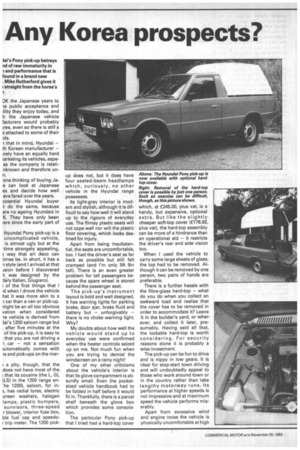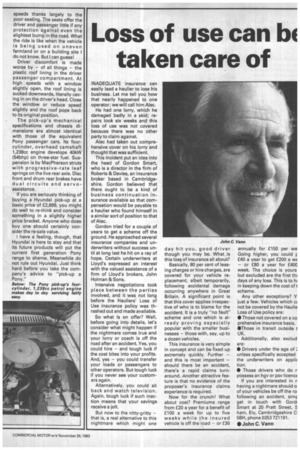Any Korea prospects?
Page 40

Page 41

If you've noticed an error in this article please click here to report it so we can fix it.
DK the Japanese years to le public acceptance and ility they enjoy today, and h the Japanese vehicle facturers would probably iree, even so there is still a 3 attached to some of their cts.
-1 that in mind, Hyundai — th Korean manufacturer — ;rely have an equally hard larketing its vehicles, espeas the company is relatinknown and therefore un n.
one thinking of buying Jae can look at Japanese es and decide how well aye fared over the years. aotential Hyundai buyer t do the same, because are no ageing Hyundais in K. They have only been iere since the early part of Hyundai Pony pick-up is a uncomplicated vehicle, is almost ugly but at the time strangely appealing, way that art deco can times be. In short, it has a style (and I arrived at that tsion before I discovered it was designed by the lary Italian, Giugiaro).
! of the first things that I .c1 when I drove the vehicle hat it was more akin to a -1 car than a van or pick-up. night be an all too obvious vation when considered le vehicle is derived from this 1200 saloon range but • after five minutes at the of the pick-up, it is easy to that you are not driving a car — not a sensation 3utomatically comes with -is and pick-ups on the mar ; a pity, though, that the does not have most of the that its cousins (the L, GL ;LS) in the 1200 range en-he 1200L saloon, for in3, has radial tyres, electric ;Green washers, halogen lamps, plastic bumpers, sunvisors, three-speed r blower, interior fuse box, ble fuel cap and speedotrip meter. The 1200 pick
up does not, but it does have four sealed-beam headlamps which, curiously, no other vehicle in the Hyundai range possesses.
Its light-grey interior is modern and stylish, although it is difficult to say how well it will stand up to the rigours of everyday use. The flimsy plastic seats will not cope well nor will the plastic floor covering, which looks destined for injury.
Apart from being insubstantial, the seats are uncomfortable, too. I had the driver's seat as far back as possible but still felt cramped (and I'm only 5ft 9in tall). There is an even greater problem for tall passengers because the spare wheel is stored behind the passenger seat.
The pick-up's instrument layout is bold and well designed. It has warning lights for parking brake, door ajar, brake fluid and battery but — unforgivably — there is no choke warning light. Why?
My doubts about how well the vehicle would stand up to everyday use were confirmed when the heater controls seized up on me. Not much fun when you are trying to demist the windscreen on a rainy night!
One of my other criticisms about the vehicle's interior is that its glove compartment is absurdly small. Even the pocketsized vehicle handbook had to be folded in half before it would fit in. Thankfully, there is a parcel shelf beneath the glove box which provides some consolation.
The particular Pony pick-up that I tried had a hard-top cover which, at £245.00, plus vat, is a handy, but expensive, optional extra. But like the slightly cheaper soft-top cover (£176.92, plus vat), the hard-top assembly can be more of a hindrance than an operational aid — it restricts the driver's rear and side vision too.
When I used the vehicle to carry some large sheets of glass, the top had to be removed. Al though it can be removed by one person, two pairs of hands are preferable.
There is a further hassle with the fibre-glass hard-top — what do you do when you collect an awkward load and realise that the cover has to be removed in order to accommodate it? Leave it in the builder's yard, or wherever, and collect it later, presumably. Having said all that, the lockable hard-top is worth considering. For security reasons alone it is probably a wise investment.
The pick-up can be fun to drive and is nippy in low gears. It is ideal for stop-start town driving and will undoubtedly appeal to those who work around town or in the country rather than take lengthy motorway runs. Its performance at higher speeds is not impressive and at maximum speed the vehicle performs mis erably.
Apart from excessive wind and engine noise the vehicle is physically uncomfortable at high speeds thanks largely to the poor seating. The seats offer the driver and passenger little if any protection against even the slightest bump in the road, What the ride is like when the vehicle is being used on uneven farmland oron a building site I do not know. But I can guess!
Driver discomfort is made worse by — of all things — the plastic roof lining in the driver passenger' compartment. At high speeds with a window slightly open, the roof lining is sucked downwards, literally caving in on the driver's head. Close the window or reduce speed slightly and the roof pops back to its original position.
The pick-up's mechanical specifications and chassis di mensions are almost identical with those of the equivalent Pony passenger cars. Its four cylinder, overhead camshaft 1,238cc engine develops 40kW (54bhp) on three-star fuel. Sus pension is by MacPherson struts with progressive-rate leaf springs on the live rear axle. Disc front and drum rear brakes have dual circuits and servoassistance.
If you are seriously thinking of buying a Hyundai pick-up at a basic price of £2,899, you might do well to re-think and consider something in a slightly higher price bracket. Anyone who does buy one should certainly consider the re-sale value.
I have a feeling, though, that Hyundai is here to stay and that its future products will put the current first generation Pony range to shame. Meanwhile do not rule out Hyundai. Just think hard before you take the company's advice to "pick-up a Pony."
Below: The Pony pick-up's fourcylinder, 1,238cc petrol engine makes day to day servicing fairly easy.




























































































